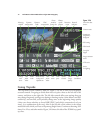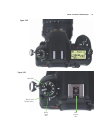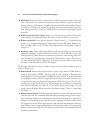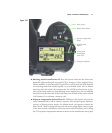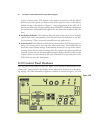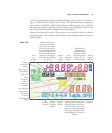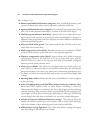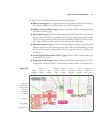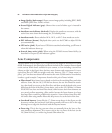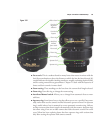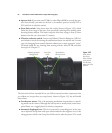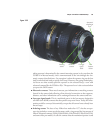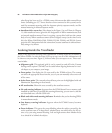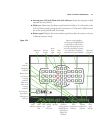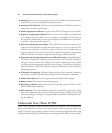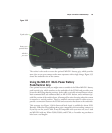
■ Image Quality (dark orange). Shows current image quality, including JPEG, RAW,
and RAW+JPEG Fine, Norm, or Basic.
■ Secure Digital indicator (gray). Shows when a card of either type is inserted in
the camera.
■ Autofocus-area indicator (dark red). Displays the autofocus area status, with the
active focus zone shown from among the 39 available points.
■ Autofocus mode. Shows whether AF-A, AF-S, or AF-C focus modes are active.
■ ISO indicator (brown). Displayed when you’ve set the D7000 to adjust ISO for
you automatically.
■ GPS active (pink). If you have a GPS device attached and working, you’ll know it
when this indicator shows up.
■ Interval timer active (pink). When using the D7000’s interval timer facility (as
described in Chapter 8), this indicator appears.
Lens Components
The lens shown at left in Figure 3.31 is a typical lens that might be mounted on a Nikon
dSLR. Unfortunately, this particular lens doesn’t include all the common features found
on the various Nikon lenses available for your camera, so I am including a second lens
(shown at right in the figure) that does have more features and components. It’s not a
typical lens that a D7000 user might work with, however. This 17-35mm zoom is a
pricey “pro” lens that costs about half as much as the entire D3100 camera. Nevertheless,
it makes a good example. Components found on this pair of lenses include:
■ Filter thread. Most lenses have a thread on the front for attaching filters and other
add-ons. Some, like the 18-55 VR kit lens shown, also use this thread for attach-
ing a lens hood (you screw on the filter first, and then attach the hood to the screw
thread on the front of the filter). Some lenses, such as the AF-S Nikkor 14-24mm
f/2.8G ED lens, have no front filter thread, either because their front elements are
too curved to allow mounting a filter and/or because the front element is so large
that huge filters would be prohibitively expensive. Some of these front-filter-hos-
tile lenses allow using smaller filters that drop into a slot at the back of the lens.
■ Lens hood bayonet. Lenses like the 17-35mm zoom shown in the figure use this
bayonet to mount the lens hood. Such lenses generally will have a dot on the edge
showing how to align the lens hood with the bayonet mount.
■ Focus ring. This is the ring you turn when you manually focus the lens, or fine-
tune autofocus adjustment. It’s a narrow ring at the very front of the lens (on the
18-55mm kit lens), or a wider ring located somewhere else.
David Busch’s Nikon D7000 Guide to Digital SLR Photography82



